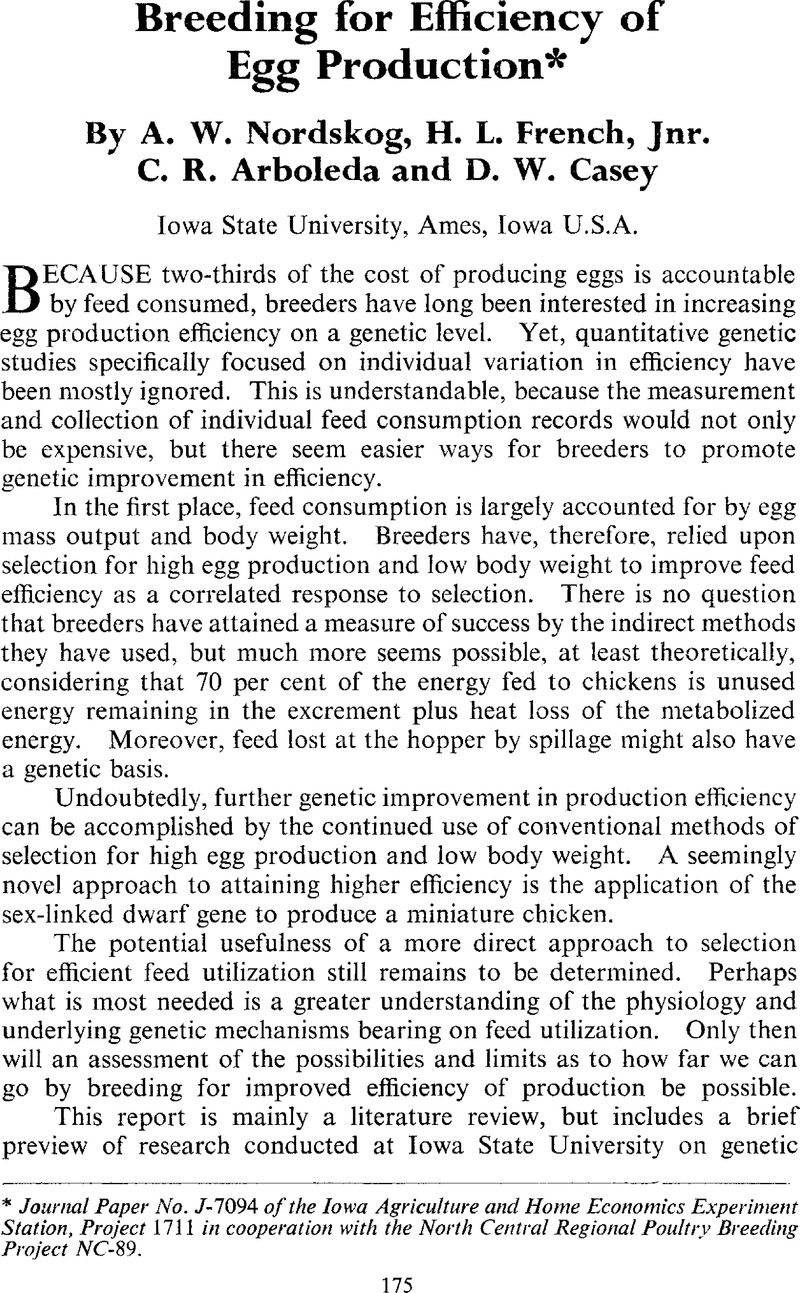Crossref Citations
This article has been cited by the following publications. This list is generated based on data provided by Crossref.
Nordskog, A.W.
Tolman, H.S.
Casey, D.W.
and
Lin, C.Y.
1974.
Selection in Small Populations of Chickens.
Poultry Science,
Vol. 53,
Issue. 3,
p.
1188.
Marks, H.L.
and
Britton, W.M.
1976.
The Relationship of Feed and Protein Efficiency to Other Egg Production Traits.
Poultry Science,
Vol. 55,
Issue. 3,
p.
1149.
Pym, R. A. E.
and
James, J. W.
1979.
Selection for food conversion in broilers: Predicted responses to selection for economic efficiency.
British Poultry Science,
Vol. 20,
Issue. 1,
p.
99.
Bordas, A.
and
Merat, P.
1981.
Genetic variation and phenotypic correlations of food consumption of laying hens corrected for body weight and production.
British Poultry Science,
Vol. 22,
Issue. 1,
p.
25.
McPhee, C. P.
Burton, H. W.
and
Fuelling, D. E.
1982.
Selection for high specific gravity of eggs in a flock of Australorp hens.
British Poultry Science,
Vol. 23,
Issue. 3,
p.
215.
Bentsen, Hans Bernhard
1983.
Genetic Variation in Feed Efficiency of Laying Hens at Constant Body Weight and Egg Production.
Acta Agriculturae Scandinavica,
Vol. 33,
Issue. 4,
p.
289.
Bentsen, Hans Bernhard
1983.
Genetic Variation in Feed Efficiency of Laying Hens at Constant Body Weight and Egg Production.
Acta Agriculturae Scandinavica,
Vol. 33,
Issue. 4,
p.
305.
RENDEN, J.A.
McDANIEL, G.R.
and
McGUIRE, J.A.
1984.
Egg Characteristics and Production Efficiency of Dwarf (dw) White Leghorn Hens Divergently Selected for Body Weight.
Poultry Science,
Vol. 63,
Issue. 2,
p.
214.
DAMME, K.
PIRCHNER, F.
WILLEKE, H.
and
EICHINGER, H.
1986.
Fasting Metabolic Rate in Hens.
Poultry Science,
Vol. 65,
Issue. 4,
p.
616.
Al Bustany, Zuhair
and
Elwinger, Klas
1986.
Effect of Dietary Protein Concentration on Performance of Hens Selected on Low Protein Diet and Grouped According to Their Early Production.
Acta Agriculturae Scandinavica,
Vol. 36,
Issue. 3,
p.
264.
Braastad, B. O.
and
Katle, J.
1989.
Behavioural differences between laying hen populations selected for high and low efficiency of food utilisation.
British Poultry Science,
Vol. 30,
Issue. 3,
p.
533.
SABRI, H.M.
WILSON, H.R.
WILCOX, C.J.
and
HARMS, R.H.
1991.
Comparison of Energy Utilization Efficiency Among Six Lines of White Leghorns.
Poultry Science,
Vol. 70,
Issue. 2,
p.
229.
Katle, Jessica
1991.
Selection for efficiency of food utilisation in laying hens: Causal factors for variation in residual food consumption.
British Poultry Science,
Vol. 32,
Issue. 5,
p.
955.
Katle, Jessica
and
Kolstad, Nils
1991.
Selection for efficiency of food utilisation in laying hens: Direct response in residual food consumption and correlated responses in weight gain, egg production and body weight.
British Poultry Science,
Vol. 32,
Issue. 5,
p.
939.
Katle, Jessica
1992.
Relationship between Food Consumption in Growing Chicks and their Residual Food Consumption as Adult Laying Hens.
Acta Agriculturae Scandinavica, Section A - Animal Science,
Vol. 42,
Issue. 1,
p.
14.
SCHULMAN, N.
TUISKULA-HAAVISTO, M.
SIITONEN, L.
and
MÄNTYSAARI, E.A.
1994.
Genetic Variation of Residual Feed Consumption in a Selected Finnish Egg-Layer Population.
Poultry Science,
Vol. 73,
Issue. 10,
p.
1479.
Klein, Monika
Neubert, Marlies
Strobel, E.
and
Hoffmann, L.
1998.
Energy metabolism in laying hens of different body weight‐genotypes.
Archiv für Tierernaehrung,
Vol. 51,
Issue. 4,
p.
263.
Flock, D.K.
1998.
Genetic-economic aspects of feed efficiency in laying hens.
World's Poultry Science Journal,
Vol. 54,
Issue. 3,
p.
225.
Zhang, W.
and
Aggrey, S.E.
2003.
Genetic variation in feed utilization efficiency of meat-type chickens.
World's Poultry Science Journal,
Vol. 59,
Issue. 3,
p.
328.
Yuan, Jingwei
Dou, Taocun
Ma, Meng
Yi, Guoqiang
Chen, Sirui
Qu, Lujiang
Shen, Manman
Qu, Liang
Wang, Kehua
and
Yang, Ning
2015.
Genetic parameters of feed efficiency traits in laying period of chickens.
Poultry Science,
Vol. 94,
Issue. 7,
p.
1470.



